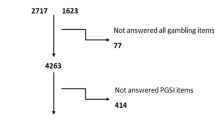Abstract
This paper reports on data relating to adolescent gambling, problem gambling and correlates of problem gambling. Participation was strongly tied to age, with only 39% of grade 5 students reporting gambling and over 80% of grade 11 reporting gambling. A large percentage of the gambling involvement was on noncommercial private bets such as card games, dice games, sports bets and games of skill. Interestingly most students rated gambling as less enjoyable than most other activities including reading. In general the students understood that gambling was mostly a matter of luck, however, the students had a very poor understanding of random chance. Problem gambling was negatively correlated with the effectiveness of coping skills and the student’s understanding of random chance. We also found an interaction between coping skills and knowledge, suggesting that the combination of poor coping skills and a poor understanding of random chance are particularly important in understanding adolescent problem gambling.


Similar content being viewed by others
References
Allen, L., Cipielewski, J., & Stanovich, K. E. (1992). Multiple indicators of children’s reading habits and attitudes: Construct validity and cognitive correlates. Journal of Educational Psychology, 84, 489–503.
Bandura, A. (1992). Self-efficacy mechanism in psychobiologic functioning. In: R. Schwarzer (Ed.), Self-efficacy: Thought control of action. (pp. 355–394). Washington, DC: Hemisphere.
Bandura, A. (1995). Exercise of personal and collective efficacy in changing societies. In: A. Bandura (Ed.), Self-efficacy in changing societies. (pp. 1–45). New York: Cambridge University Press.
Blaszczynski, A. (2000). Pathways to Pathological Gambling: Identifying Typologies. The Electrical Journal of Gambling Issues, 1, http://www.camh.net/egambling/archive/index.html.
Blaszczynski, A., & Nower, L. (2002a). Identifying Youth Gamblers in Educational Settings Using the Pathway Model. Discovery 2002 conference. Responsible Gambling Council (Ontario). April 21–24, Niagara Falls, Canada.
Blaszczynski, A., & Nower, L. (2002b). A pathways model of problem and pathological gambling. Addiction, 97, 487–499.
Derevensky, J., & Gupta, R. (2004). The chase: Adolescents with gambling problems. The Electronic Journal of Gambling Issues, Issue 10.
Derevensky, J., Gupta, R., & Della Cioppa, G. (1996). A developmental perspective on gambling behavior in children and adolescents. Journal of Gambling Studies, 12(1), 49–66.
Endler, N. S., & Parker, J. D. A. (1990). Coping inventory for stressful situations (CISS): Manual. Toronto: Multi Health Systems.
Folkman, S., & Lazarus, R. S. (1988). Ways of coping questionnaire manual. Redwood City, CA: Consulting Psychologists Press.
Griffiths, M. (1990). The cognitive psychology of gambling. Journal of Gambling Studies, 6(1), 31–42.
Griffiths, M. (1995). Adolescent gambling. London: Routledge.
Gupta, R., & Derevensky, J. L. (1998a). Adolescent gambling behavior: A prevalence study and examination of the correlates associated with problem gambling. Journal of Gambling Studies, 14(4) 319–345.
Gupta, R., & Derevensky, J. L. (1998b). An empirical examination of Jacobs’ General Theory of Addictions. Do Adolescent gambling fit the theory? Journal of Gambling Studies, 14(1), 17–49.
Gupta, R., Marget, N., & Derevensky, J. (2000). Adolescent problem gamblers: A preliminary analysis of their coping skills. Paper presented at the Ontario Conference on Problem and Compulsive Gambling, Niagara Falls, May.
Herman, J., Gupta, R., & Derevensky, J. (1997). Children’s cognitive perceptions of gambling using a 6/49 task. Paper presented at the Canadian Foundation for Compulsive Gambling Conference, Toronto, June.
Jacobs, D. F. (1988). Evidence for a common dissociative-like reaction among addicts. Journal of Gambling Behavior, 4, 27–37.
Ladouceur, R., Dube, D., & Bujold, A. (1994). Prevalence of pathological gambling and related problems among college students in the Quebec metropolitan area. Canadian Journal of Psychiatry, 39(5), 289–293.
Ladouceur, R., & Gaboury, A. (1988). Effects of limited and unlimited stakes on gambling behavior. Journal of Gambling Behavior, 4(2), 119–126.
Marlatt, .G. A., &. Gordon, J. R. (Eds.) (1985). Relapse prevention: Maintenance strategies in the treatment of addictive behaviours. New York: Guildford.
Morgan, W. G. (2000). Origin and history of an early TAT card: Picture C. Journal of Personality Assessment, 74, 88–94.
Room, R., Turner, N. E., & Ialomiteanu, A. (1999). Community effects of the opening of the Niagara Casino: A first report. Addiction, 94, 1449–1466.
Shaffer, H. J., Hall, M. N., & Vander Bilt, J. (1997). Estimating the prevalence of disordered gambling behavior in the United States and Canada: A Meta-analysis. Boston: Harvard Medical School Division on Addictions.
Shaffer, H. J., Labrie, R., Scanlan, K. M., & Cummings, T. N. (1994). Pathological gambling among adolescents: Massachusetts Gambling Screen (MAGS). Journal of Gambling Studies, 10, 339–362.
Sklar, S. M., Annis, H. M., & Turner, N. E. (1997). Development of the drug-taking confidence questionnaire: A measure of coping self-efficacy. Addictive Behaviors, 22, 655–670.
Toneatto, T. (1999). Cognitive psychopathology of problem gambling. Substance Use and Misuse, 34(11), 1593–1604.
Toneatto, T., Blitz-Miller, T., Calderwood, K., Dragonetti, R., & Tsanos, A. (1997). Brief report: Cognitive distortions in heavy gambling. Journal of Gambling Studies, 13(3), 253–266.
Turner, N. E., & Liu, E. (1999). The naive human concept of random events. Paper presented at the 1999 conference of the American Psychological Association, Boston.
Turner, N. E., Wiebe, J., Falkowski-Ham, A., Kelly, J., & Skinner, w. (2005). Public awareness of responsible gambling and gambling behaviours in Ontario. International Gambling Studies, 5(1), 95–112.
Turner, N., Zangeneh, M., & Littman-Sharp, N. (2006). The experience of gambling and its role in problem gambling. International Gambling Studies, 6, 237–266.
Wagenaar, W. A. (1988). Paradoxes of gambling behavior. London: Lawrence Erlbaum Associates.
Walker, M. B. (1992). Irrational thinking among slot machine players. Journal of Gambling Studies, 8(3), 245–261.
Winters, K. C., Stinchfield, R. D., & Fulkerson, J. (1993). Toward the development of an adolescent gambling severity scale. Journal of Gambling Studies, 9(1), 63–84.
Author information
Authors and Affiliations
Corresponding author
Rights and permissions
About this article
Cite this article
Turner, N.E., Macdonald, J., Bartoshuk, M. et al. Adolescent Gambling Behaviour, Attitudes, and Gambling Problems. Int J Ment Health Addiction 6, 223–237 (2008). https://doi.org/10.1007/s11469-007-9117-1
Received:
Accepted:
Published:
Issue Date:
DOI: https://doi.org/10.1007/s11469-007-9117-1




